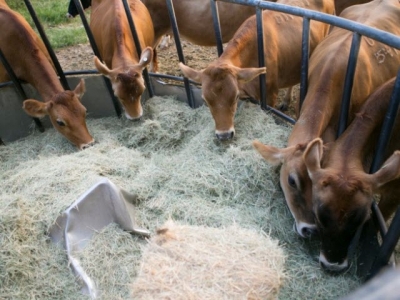Essential oils in feed improve meat quality: study

Use of clove and rosemary essential oils with encapsulated active principles in feed may reduce oxidation of meat and improve shelf life, say researchers.
An international team of researchers in Brazil and Spain examined the use essential oils in feed on the meat quality of grain-finished cattle. The group published its work in the journal of Meat Science.
“This study aimed to investigate the effects of essential oils (clove and rosemary), their encapsulated active principles (eugenol, thymol and vanillin mixture) and blends thereof on the meat quality of feedlot-finished heifers fed on high-grain diets,” the researchers said.
Researchers found that use of the feed additives did not alter fat thickness, marbling, muscle area, thawing, drip loss or pH for meat produced, they said. However, the supplements influenced color loss and lipid oxidation.
“Cooking losses were affected at 14 days of aging by the diet containing clove and rosemary essential oil and the active principles (eugenol, thymol and vanillin),” said the researchers. “In general, the dietary inclusion of these compounds lessened color degradation, increased antioxidant activity and decreased lipid oxidation in the meat. Thus, these compounds have potential use in animal feed to maintain [and, or] improve meat quality during its shelf life.”
Synergistic effect on animal metabolism and beef quality
Different plants have specific active components that alter characteristics, said the authors.
Essential oils, they noted, are a mix of terpenoids primarily including monoterpenes and sesquiterpenes and sometimes diterpenes.
“They also include a variety of low molecular weight aliphatic hydrocarbons, acids, alcohols, aldehydes, acyclic esters or lactones and N- and S-containing compounds, such as coumarins, and homologs of phenylpropanoids may also be present,” said the researchers. “These products may act as antimicrobials (oils of clove, rosemary, thyme and vanillin are some of the most effective due to the presence of phenolic compounds) and antioxidants, benefiting the immune and digestive system of animals, which is reflected in their performance indices.”
When a blend of oils is used, there may be a synergistic effect on animal metabolism and beef quality, they said.
Plants containing thymol and carvacrol are considered to have “high antioxidant potential” because they include phenolic terpenes, they said. Vanilin, has been linked to antimicrobial and antioxidant properties.
However, rosemary (Rosmarinus officinalis) is considered to have more antioxidant activity than other essential oils, especially in meat, they said. It has several phenolic compounds, added the team.
Clove (Syzygium aromaticum) also provides a range of phenolic compounds and is considered to have antimicrobial and antioxidant properties, said the researchers.
Some previous work has explored the potential for essential oils to alter meat quality or prolong the shelf life, however information on their interaction with meat quality is limited, they said.
Feed trial details
During the feeding trial, 40 heifers were given one of five trial diets for a period of 73 days, said the researchers.
The diets included a control, which was not supplemented with essential oil or active principles (eugenol, thymol and vanillin); a diet (ROS) with 4g per day of rosemary essential oil; A diet with just the active principles (BLE) at 4g per day; the same blend at 2g per day and clove essential oil at 2g per day (BCL); and the active principle blend at 1.33g a day with rosemary and clove essential oils at 1.33g per day (BRC), they said.
Both essential oils and the encapsulated blend were commercially available, they added.
Meat generated was assessed for pH, fat thickness, muscle area, color, texture, marbling, water loss during thawing, drip and cooking, they said. Tissue was evaluated 24 hours post-harvest and after ageing of 7 or 14 days prior to freezing and storage.
Antioxidant activity, radical scavenging activity and lipid oxidation also were examined, they said.
Results
The feed additive did not alter some aspects of meat condition, said the researchers. Fat thickness, pH, muscle area, marbling, along with thawing and drip losses remained similar regardless of diet.
However, the additives altered cooking losses, color, lipid oxidation and texture, they said. “Aging affected texture and lipid oxidation,” they added.
“The diets with essential oil and the active principle blend reduced the lipid oxidation and reduced the color losses in relation to control diet,” they said. “The essential oil and active principles or its blend have potential use in animal feed aiming to maintain [and, or] improve meat quality during shelf life.”
The study was partially funded by Safeeds Nutrição Animal.
Related news
Tools

Phối trộn thức ăn chăn nuôi

Pha dung dịch thủy canh

Định mức cho tôm ăn

Phối trộn phân bón NPK

Xác định tỷ lệ tôm sống

Chuyển đổi đơn vị phân bón

Xác định công suất sục khí

Chuyển đổi đơn vị tôm

Tính diện tích nhà kính

Tính thể tích ao



 Is tree bark the remedy for diarrhea in…
Is tree bark the remedy for diarrhea in…  Cattle could benefit from enzyme boost, says study
Cattle could benefit from enzyme boost, says study